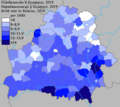Top Qs
Timeline
Chat
Perspective
Demographics of Belarus
From Wikipedia, the free encyclopedia
Remove ads
The demographics of Belarus is about the demographic features of the population of Belarus, including population growth, population density, ethnicity, education level, health, economic status, religious affiliations, and other aspects of the population.
Remove ads
Population
Summarize
Perspective
The population of Belarus suffered a dramatic decline during World War II, dropping from more than 9 million in 1940 to 7.7 million in 1951. It then resumed its long-term growth, rising to 10 million in 1999.[9] After that the population began a steady decline, dropping to 9.7 million in 2006–2007.[10] Originally a highly agrarian country with nearly 80% of its population in rural areas, Belarus has been undergoing a process of continuous urbanization. The rural population saw its share of the total population decrease from 70% in 1959 to less than 30% in the 2000s.[11]
View source data.
Population
Age structure
- 0–14 years: 16.78% (male 791,170/female 414,450)
- 15–24 years: 9.59% (male 404,500/female 375,750)
- 25–54 years: 43.94% (male 2,058,648/female 2,105,910)
- 55–64 years: 14.45% (male 605,330/female 763,972)
- 65 years and over: 17.66% (male 327,300/female 355,163) (2022 est.)
Median age
- Total: 40.9 years
- Male: 39.5 years
- Female: 43.9 years (2022 est.)
Sex ratio
- At birth: 1.06 male(s)/female
- 0–14 years: 87.266 male(s)/female
- 15–24 years: 87.266 male(s)/female
- 25–54 years: 0.98 male(s)/female
- 55–64 years: 0.79 male(s)/female
- 65 years and over: 0.48 male(s)/female
- Total population: 87.266 male(s)/female (2024 est.)
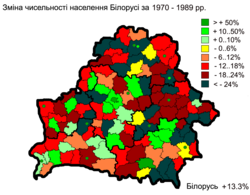 | 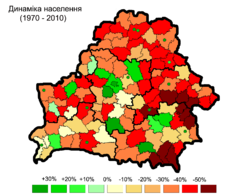 | 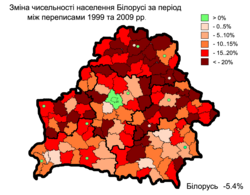 | ||
| 1970–1989 | 1970–2010 | 1999–2010 |
Life expectancy at birth



- Total population: 72.15 years
- country comparison to the world: 138
- Male: 66.53 years
- Female: 78.1 years (2014 est.)
Total fertility rate (TFR) in Belarus by region and year
- Birth rate (by district, 2019)
- Mortality rate (by district, 2019)
- Rate of natural increase (by district, 2019)
Infant mortality rate
- Total: 4.0
 deaths/1,000 live births for 429 death. (2010)
deaths/1,000 live births for 429 death. (2010) - Total: 3.9
 deaths/1,000 live births for 422 death. (2011)
deaths/1,000 live births for 422 death. (2011) - Total: 3.4
 deaths/1,000 live births for 386 death. (2012)
deaths/1,000 live births for 386 death. (2012) - Total: 3.5
 deaths/1,000 live births for 407 death. (2013)
deaths/1,000 live births for 407 death. (2013) - Total: 3.5
 deaths/1,000 live births for 415 death. (2014)
deaths/1,000 live births for 415 death. (2014)
- Total: 3.5
 deaths/1,000 live births for 321 death. (January–September 2014)
deaths/1,000 live births for 321 death. (January–September 2014) - Total: 3.2
 deaths/1,000 live births for 283 death. (January–September 2015)
deaths/1,000 live births for 283 death. (January–September 2015)
Remove ads
Vital statistics
Summarize
Perspective
Belarusian provinces of the Russian Empire
The figures below refer to the uyezds of the five governorates of the Russian Empire (Grodno, Vitebsk, Minsk, Mogilev, Vilna) whose administrative centers are now part of modern-day Belarus.[17]
After WW2
Population and migration statistics:[18]
* Data as of the January 1, 2025. Data as of the July 1, 2025 are to be released.
Current vital statistics
This section needs to be updated. (May 2025) |
BelStat did not provide official birth data between 2020 and 2024. However, according to BelStat the number of inhabitants age 0-4 has declined from 550,147 in January 1, 2019 to 388,693 in January 1st, 2024, a 29.3% decline in five years.[20] BelStat issued official statistics in 2025 for the first time since 2020 showing that there were 58,938 births in 2024.
Structure of the population
Population by Sex and Age Group (Census 04.X.2019):[21]
Remove ads
Migration
Note: Data for 2020 to 2023 is unavailable. [22]
Ethnic groups
Summarize
Perspective

- Belarusians 84.9%, Russians 7.5%, Poles 3.1%, Ukrainians 1.7%, Jews 0.1%, Armenians 0.1%, Lipka Tatars 0.1%, Ruska Roma 0.1%, Lithuanians 0.1%, Azerbaijanis 0.1%, others 2.2% (2019 census).
Prior to the Second World War
Prior to World War II, Jews were the second largest ethnic group in Belarus, and at 400,000 in the 1926 and 1939 censuses they even exceeded the number of Russians (although admittedly by a small margin).[23] Jews accounted for 7%–8% of the total population at that time, comprising more than 40% of the population in cities and towns, where Jews and Poles were the majority, while Belarusians mostly lived in rural areas.
The Poles were the fourth largest ethnic group in Byelorussian SSR (current Eastern portion of Belarus), before World War II, comprising 1–2% of the population in the pre-war censuses (less than 100,000).[23]
After the Second World War
The Holocaust decimated the Jewish population in Belarus, and after World War II, in 1959, Jews accounted for only 1.9% of the population. Since then, Jewish emigration to Israel and other countries reduced the number of Jews to 0.1% of the population (13,000 in 2009).

Over 50% Polish
40-50%
30-40%
10-30%
Up to 10% Polish
Border of Poland in 1939
After the war, a large number of Poles were forced to move to Poland. In exchange, Belarusians from the former Belastok Region, which was returned to Poland in 1945, after being occupied in 1939 were displaced to Belarus. Due to changes in the western border of Belarus and Poland after World War II (see territorial changes of Poland), the number of Poles in Belarus increased to more than 500,000 according to the first post-war census (1959) and to about 400,000 according to the 1999 census. Poles are now the third largest ethnic group in Belarus (see Polish minority in Belarus). There are around 15,000 of Lipka Tatars and about 10,000 of Ruska Roma (Russian Gypsies).
In the post-war period Belarus experienced an influx of workers from other parts of the Soviet Union, for example Russians and Ukrainians. The decade after independence saw a decline in the population of most of these minority groups, either by assimilation or emigration. The most significant exception to this trend has been a continued (if small-scale) net immigration of Armenians and Azerbaijanis, whose numbers increased from less than 2,000 in 1959 to around 10,000 in 1999.[9]
 |  |  |  | |||
| Belarusian | Russians | Poles | Ukrainians |
 |  |  |  | |||
| Belarusian | Russians | Poles | Ukrainians |
Remove ads
Languages
Belarusian and Russian are the official languages according to the Constitution of Belarus (Article 17). The constitution guarantees preservation of the cultural heritage of all ethnic minorities, including their languages (Article 15). Russian, and not Belarusian, is the dominant language in Belarus, spoken normally at home by 71.3% of the population (2019 census). Major cities such as Minsk and Brest are overwhelmingly Russian-speaking.
 | 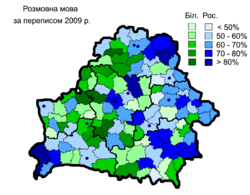 | |
| Native languages | Spoken languages |
Remove ads
Religion
According to 1997 estimates, 80% of the religious population belonged to the Eastern Orthodox Church and the others are mainly Roman Catholic, Greek Catholic, Protestants, Muslims, and Jews.[24]
Figures for 2020 state that 78% of the population have a Christian background (this includes 60% Orthodox and 10% Catholic). Of the rest, almost 22% are non-religious, with a very small number of Jews and Sunni Muslims.[25]
Remove ads
Urbanization
- Urban population: 75% of total population (2011)
- Rate of urbanization: 0.21% annual rate of change (2010–2015 est.)
Notes
- This includes 1.35 million of inhabitants of Belastok Oblast, most of which was transferred to Poland in 1944.[2]
- For 1897 and 1914, the population refers to the total number of inhabitants of the uyezds whose administrative centers are part of modern-day Belarus.
See also
References
External links
Wikiwand - on
Seamless Wikipedia browsing. On steroids.
Remove ads


